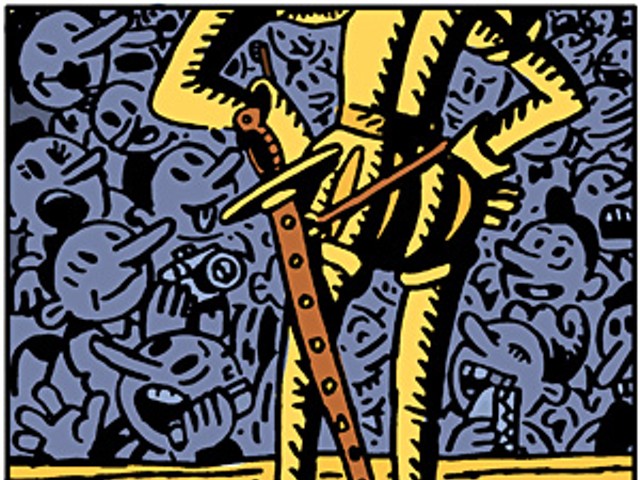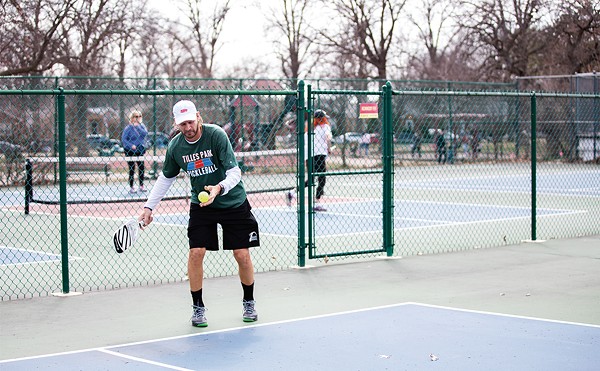Exposure 12: Implied Narratives: Paintings by Jamie Adams, Bill Kreplin and Kit Keith Reviewed in this issue.
Sift, Measure, Cultivate Using elements of fiber-based craft, three St. Louis artists create discrete but consuming installations in this exhibition of new work. Doilies burst into coral-like profusions — on oak shelves, on an accent table — in Erin Cork's Cultivating Doilies. In Sift, Gina Alvarez pins to the wall an assortment of handmade specimens — carved wood, stuffed objects spouting fabric tufts, fibrous paper cut in cell-like shapes — in a manner that suggests the aftermath of some unseen process of meticulous refinement. The end result of a live, interactive process that took place on the exhibition's opening night, Courtney Henson's Get Out Your Measuring Cups displays piles of paper cups, emptied of soil that was publicly distributed for planting and instead adorned with pen drawings of growth-motivating proclamations and other natural imagery. All of the work mines the tension between organic shapes and methods and the deliberately manufactured. While the three pieces work in concert to create an integrated conversation, Alvarez displays the most material, chromatic and compositional finesse — with a particular sensitivity to the weight of things, or, more accurately, their capacity to appear nearly weightless. Through September 27 at Fontbonne University Gallery of Fine Art, 6800 Wydown Boulevard (in the Fine Arts Building), Clayton; 314-889-1431 or www.fontbonne.edu. Hours: 9 a.m.-4 p.m. Mon.-Fri. (open till 7 p.m. Tue. and till 2:30 p.m. Fri.); noon-4 p.m. Sat.
Ongoing
Ansel Adams in Yosemite Ansel Adams' photographs of Yosemite National Park long ago became the ubiquitous stuff of classic Americana — appearing so commonly on greeting cards, posters, postage stamps and calendars that it seems strange to encounter them in an art museum. Collectively, Adams' depictions of the American West became the icon for our notion of Mighty Wilderness around the time that Hollywood generated a similar myth via the Western. Reality, in short, is not often memorable. Looking at Adams' work as art takes a little effort, peeling back the layers of their less-sublime resemblance to cheap reproductions — or, perhaps more sublimely, to languorous landscape pans in John Ford films. But make the investment and you'll be rewarded: The real work holds up. You have to peer deeply into these pieces — as though through Adams' camera lens itself — framing minute-seeming valleys of trees, dwarfed beneath massive cloud-covered mountains. In the low light of the museum, the experience of looking at these images compels an almost voyeuristic awe at all things natural — that these exquisitely perfect photographs are, possibly, some of the closest things to nature we can readily know. Through September 20 at the Saint Louis Art Museum, 1 Fine Arts Drive (in Forest Park); 314-721-0072 or www.slam.org. Hours: 10 a.m.-5 p.m. Tue.-Sun. (open till 9 p.m. Fri.).
Mary Lee Bendolph, Gee's Bend Quilts, and Beyond The singularly beautiful quilts from Gee's Bend, a small African-American community in Alabama, has traveled to major museums across the United States for the past several years, garnering accolades as well as controversy regarding the possible exploitation of the self-taught artists it features. Politics and media aside, it's a show worth viewing on the merits of the work included. The quilts made by the women of Gee's Bend, in nearly unwavering tradition for over a century, are pieces of honest beauty and startling modernity — resembling hard-edged abstract paintings or midcentury design. Whether it's legitimate to liken the work to canonical twentieth-century art is too heady a question for the quilts' elemental appeal. From blocky, patched-together swatches of used corduroy and denim, eccentric compositions of vivid colors emerge, creating bold tableaux. The exhibit also includes prints made from the quilted patterns and sculptures by two notable "outsider" artists from the region, Thornton Dial and Lonnie Holley, who were introduced to the quilters and created artworks that celebrated their dialogue and shared cultural history. Through September 13 at the Missouri History Museum, Lindell Boulevard and DeBaliviere Avenue; 314-746-4599 or www.mohistory.org. Hours: 10 a.m.-6 p.m. daily (open till 8 p.m. Tue.).
Ideal (Dis-) Placements: Old Masters at the Pulitzer This exhibition of canonical canvases of slain martyrs, pious virgins and other grand dilemmas borrowed from two encyclopedic museums and replaced in naturally lit contemporary galleries is a reaffirmation of the human scale. The minimalism of Tadao Ando's building design is diffused by ornate, gilt-framed compositions that date from the fourteenth to the eighteenth century, the two historical extremes meeting precisely at the fragile effects of daylight on the predominantly figural pieces. Contemplative and reverent, the show fulfills its premise so well that it seems capable of providing a discretely intimate experience for each and every viewer. Through October 3 at the Pulitzer Foundation for the Arts, 3716 Washington Boulevard; 314-754-1850 or www.pulitzerarts.org. Hours: noon-5 p.m. Wed., 10 a.m.-5 p.m. Sat.
Relics of a Glorious Past: Imperial Russian Artifacts from the Collection of Dr. James F. Cooper This assemblage of orthodox icons and the daily stuff of royalty forms a two-part essay on lost cultural splendor and the bygone transcendent art object. Framed in gilt halos, pounded metal and semiprecious stones, the small tempera-on-wood devotional paintings exemplify an anonymous milieu in which studied replication was prized over innovation, and communion with the immaterial was the subject matter of choice. Similarly, the gold-rimmed teaspoons, military regalia and assorted decorative pieces from the show's secular portion involve such an engaged level of tactile detail that they could be considered devotionally crafted. The exhibit as a whole serves as a useful reference point for contemporary art's renewed interest in gold, which seems to signify a nostalgia for creative acts deemed sacred and authentic. Through December 20 at the Saint Louis University Museum of Art, 3663 Lindell Boulevard; 314-977-2666 or sluma.slu.edu. Hours: 11 a.m.-4 p.m. Wed.-Sun.
Thomas Struth In a masterfully resonant gesture, two large-format photographs by the notable German photographer Thomas Struth have replaced the collection of old-master drawings in the Pulitzer Foundation's lower gallery. The images, Pantheon, Rome and The Restorers at San Lorenzo Maggiore, Naples, immediately predate his seminally elegant "Museum" series (which depicted people viewing canonical works of art in the world's canonical museums), but share that series' concern with the phenomenon of viewership and space. One photograph shows a cluster of minute-seeming tourists gaping skyward at the enormity of the ancient Roman sacred space; the other captures a small group of employees in the museum's rear quarters, gazing directly at the camera while rows of historical paintings lean almost casually against a wall behind them. As a pair, the photographs perform a rich exercise in perception and scale, in which you, the viewer, contemplate other viewers' contemplations of represented space, while simultaneously enacting the same action. Furthering this effect, when ascending the stairs from the lower gallery, the severe modernity of the museum suddenly resonates with Struth's ornate grand halls and coffered rotundas — making the contemporary world, for a miraculous moment, the logical conclusion of history. Through October 3 at the Pulitzer Foundation for the Arts, 3716 Washington Boulevard; 314-754-1850 or www.pulitzerarts.org. Hours: noon-5 p.m. Wed., 10 a.m.-4 p.m. Sat.
When We Build, Let Us Think That We Build Forever Home, or a sense of place, seems to be an ever-elusive but primary concern for the creative set, as this group show by local artists confirms. B.j. Vogt piles strata of Styrofoam and tufts of green twist ties to create a mountainous, occasionally green-sprouting form based on the shape of his arm. Christine D'Epiro consumes a discrete gallery space with a floor-to-ceiling patchwork of paper bags painted black and punctured with small holes that reveal bits of luminous color. The body, here, becomes a kind of location; and what seems like the density of night becomes a dense, all-consuming place. Also participating are Jessica Kiel-Wornson, Brea McAnally and Peter Marcus, who explore the spirit of the habitable environment from the stock form — or shards of form — of a house. Through September 30 at the Luminary Center for the Arts, 4900 Reber Place; 314-807-5984 or www.theluminaryarts.com. Hours: 2-7 p.m. Tue.-Wed. and noon-5 p.m. Sat.





